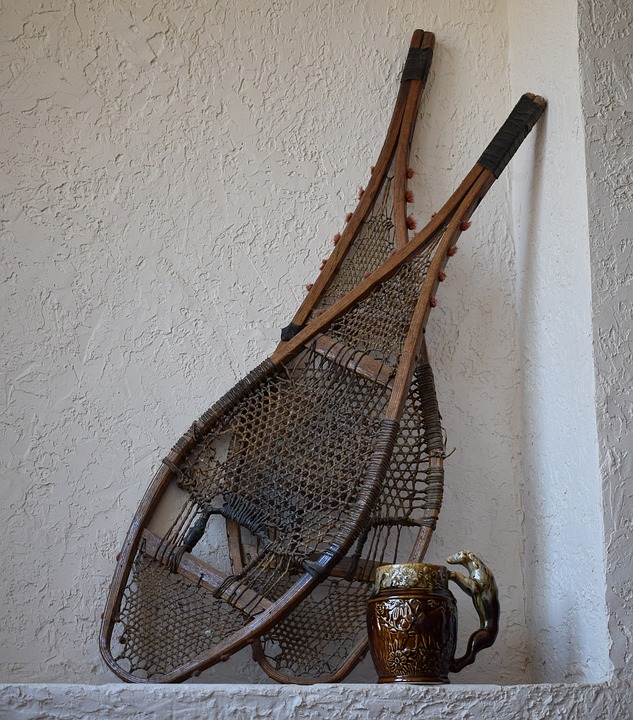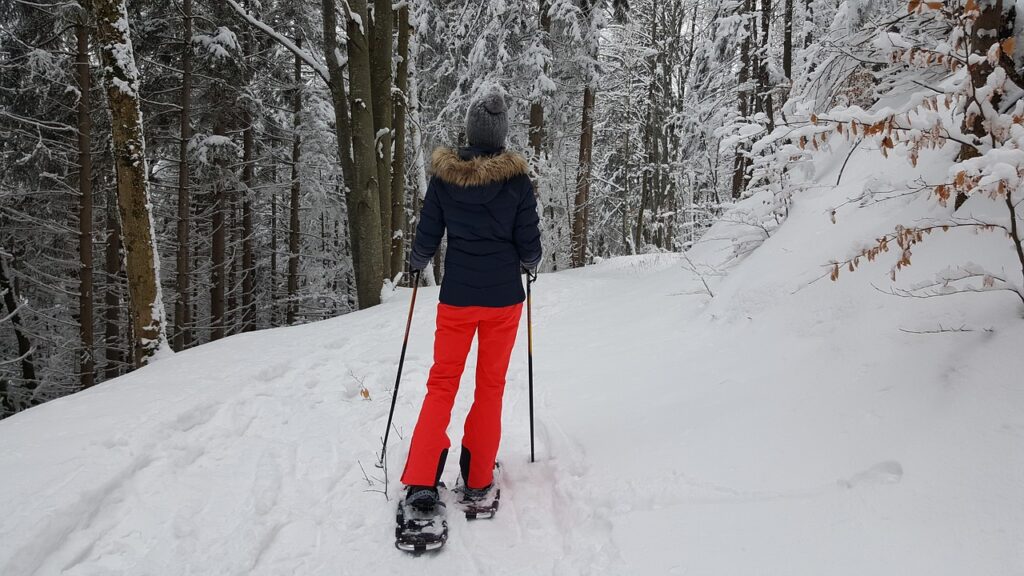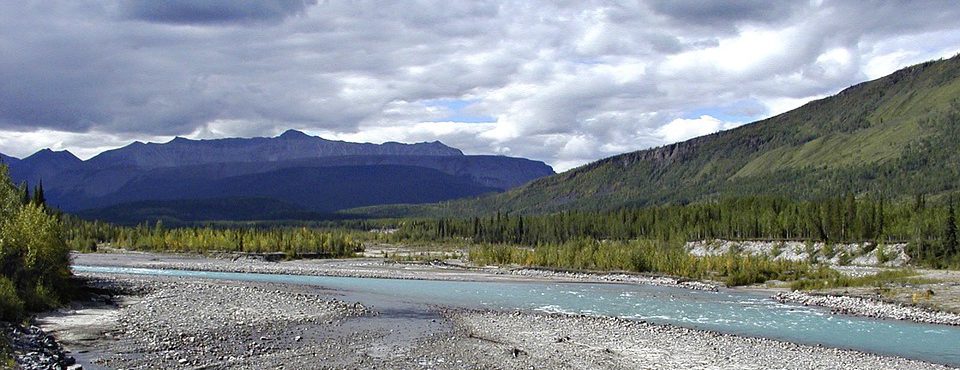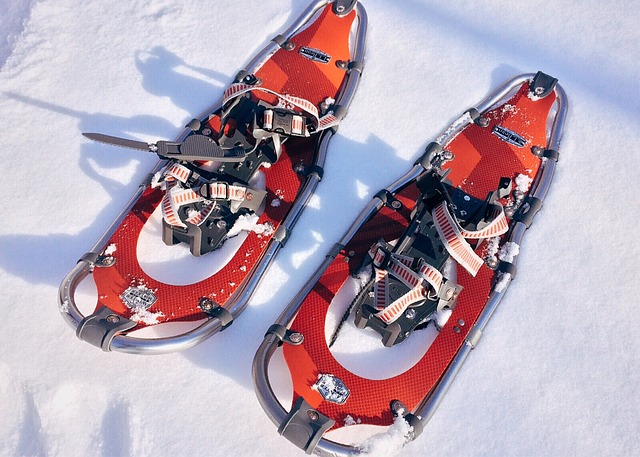Interesting Facts about Snowshoes
10 Things to Know about Snowshoes-for your benefit is a quick look at traditional and modern snowshoes, their origins, components and technical characteristics.
1. What are Snowshoes?
A snowshoe is a platform designed to support or “float” your bodyweight and backpack when walking or running over snow. This activity is best practiced over deep, powdery snow unless you are running or climbing!
2. Where do they come from?
The earliest origins of the snowshoe have appeared from Central Asia and date back to over 5000 years ago. This early snowshoe was constructed of a flat piece of leather attached to a wooden block.
3. The Traditional Snowshoe

If you had lived in North America in the early days of the ” European Arrival ” to the New World, you would have seen many First Nations and Fur Trappers wearing Traditional snowshoes.
These were constructed of a wooden frame, usually Ash, with decking made of interlaced rawhide. Everyone would have worn them for hunting, trapping and getting around.
This traditional snowshoe had its origins in North America and was usually built by the Cree First Nation or the Huron First Nations.
4. The Modern Snowshoe.
Today’s snowshoe is a very technical ” snow-platform ” made of an Aluminum (sometimes 6061) or plastic frame, complete with synthetic decking material such as Neoprene or Nytex. These materials are designed to resist cracking and breaking in extremely cold temperatures.
V-shaped tails and Light ride suspension, allow your feet to move in a more natural manner, all while cushioning the impact of your foot on the snow.
Bindings provide arch support and have easy-to-use systems for quickly getting into and out of your snowshoes.
Crampons and Heel Lift/Climbing Bars add to their hill and mountain climbing prowess. Metal cleats that can be resharpened are also included.
5. This is a form of Hiking
Recreational Snowshoeing is quite simply walking or hiking over snow. When all the leaves have fallen off the trees and the birds have gone South for the winter, why not consider Snowshoeing as a form of cardio exercise, for the winter months. It is far more invigorating than being inside a building, on a machine.
6. Why wear Snowshoes?
Studies of early life in the New World, where trappers and fur traders plied their trade in the frozen wilderness always conjure images of rugged men and women covered in furs and wearing snowshoes. Snowshoes were the only way to stay “afloat” in this deep snow.
7. Why is Snowshoeing so popular?
While these early adventurers required snowshoes for work and survival, most modern-day snowshoeing is connected to recreation.
Some exceptions, such as SAR techs, Forest Rangers, and Surveyors break this rule. Its popularity is in part due to an increase in availability at ski hills and sport’s shops. Many ski hills and sport shops rentals so that anyone can try it out without breaking the bank.
The ever-growing trend in physical fitness has also spilled into the winter season.
8. Which Snowshoes are best for you?
There are basically 3 types of snowshoes. Snowshoes are classified for; 1) Trail Use/ General Use, 2) Mountain Use, and 3) Running. Two important factors to consider when choosing your snowshoes are; 1) the terrain over which you will be travelling, and 2) your level of experience.
If you are not sure which ” shoe ” has the best fit, you are probably at the novice level, and the best shoe for you would belong in the trail or general use category. Be careful … you may become addicted!
9. Fewer Injuries
Since this is a form of walking, you are less likely to get injured on snowshoes than you could be on downhill skis, at snowboarding or even while running on ice and snow.
Snowshoeing has become a very popular winter sport and many ski hills now offer rentals and trails to cater to this ever-increasing crowd of winter enthusiasts.
This sport is very beginner-friendly and injuries are less frequent and less severe. Sore leg muscles are quickly healed and quickly forgotten over a warm beverage.
10. The Best Cardio Exercise
In one study from Harvard Health Publications, Snowshoeing was shown to burn as many calories as Cross-Country Skiing.
A 125-pound person spending 30 minutes cross-country skiing or snowshoeing can burn about 240 calories. At 185 pounds, it would require 355 calories to perform the same activity. To increase your rate of calories burnt, simply increase your rate of speed or your angle of incline.
This is an excellent Cardio exercise, and much easier and more beneficial to your overall hip and knee joint health, than “pounding” the pavement or being inside on a “machine”.
In Conclusion

Recreational Snowshoeing is quite simply … Hiking on or over snow.
The quietness of snowshoeing over powdered snow is something that you will never forget. A walk around a lake or following the riverbank in 2 feet of powdered snow certainly adds a new dimension to Hiking and soon a climb up a mountain becomes a great way to spend your weekends.
Hiking is easy and fun in the Spring, Summer, and Fall but when Winter arrives and these favourite hikes are now under 2 feet of snow, exploring on snowshoes and poles, with the sun gleaming on the snow is another reason to give this challenging winter sport a try.
If you do Snowshoe or would like to try it as an activity, this winter please don’t hesitate to offer your suggestions or questions.
If you don’t snowshoe, what sport do you participate in and has this post interested you in trying it out?
Can your Winter Sport match Snowshoeing for Calorie-Burn?

